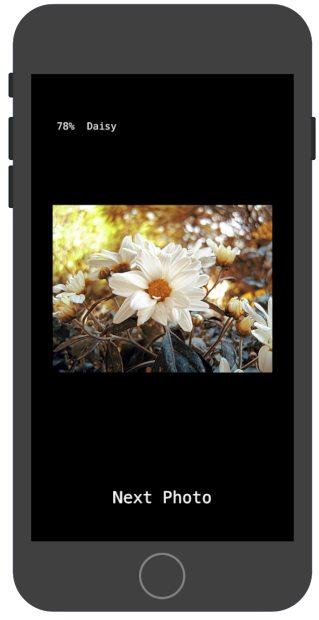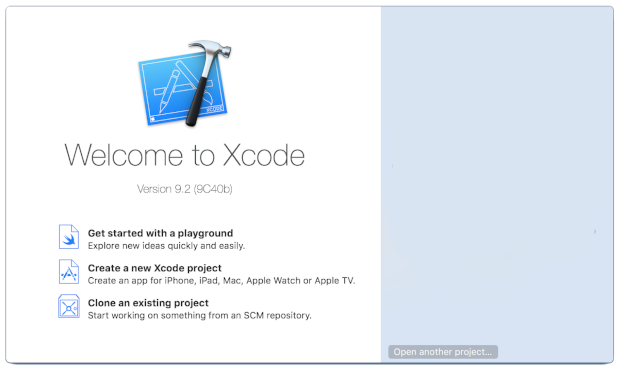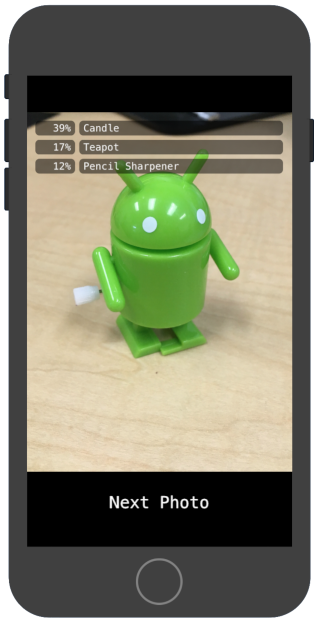What you will build
In this tutorial you will download an exported custom TensorFlow Lite model from AutoML Vision Edge. You will then run a pre-made iOS app that uses the model to identify images of flowers.

Objectives
In this introductory, end-to-end walkthrough you will use code to:
- Run a pre-trained model in an iOS app using the TFLite interpreter.
Before you begin
Install TensorFlow
Before you begin the tutorial you need to install several pieces of software:
- install tensorflow version 1.7
- install PILLOW
If you have a working Python installation, run the following commands to download this software:
pip install --upgrade "tensorflow==1.7.*" pip install PILLOW
Clone the Git repository
Using the command line, clone the Git repository with the following command:
git clone https://github.com/googlecodelabs/tensorflow-for-poets-2
Navigate to the directory of the local clone of the repository
(tensorflow-for-poets-2 directory). You will run all following code samples
from this directory:
cd tensorflow-for-poets-2
Setup the iOS app
The demo iOS app requires several additional tools:
- Xcode
- Xcode command line tools
- Cocoapods
Download Xcode
Use the following link to download Xcode on your machine.
Install Xcode command line tools
Install the Xcode command line tools by running the following command:
xcode-select --install
Install Cocoapods
Cocoapods use Ruby, which is installed by default on macOS.
To install cocoapods, run this command:
sudo gem install cocoapods Install TFLite Cocoapod
Navigate to the .xcworkspace file
The rest of this codelab needs to run directly in macOS, so close docker now (Ctrl-D will exit docker).
Use the following command to install TensorFlow Lite and create the
.xcworkspace file using cocoapods:
pod install --project-directory=ios/tflite/
Open the project with Xcode. You can open the project either through the command line or via the UI.
To open the project via the command line run the following command:
open ios/tflite/tflite_photos_example.xcworkspace
To open the project via the UI, launch Xcode and select the "Open another Project" button.

After opening the project, navigate to the .xcworkspace file
(not the .xcproject file).
Run the original app
The app is a simple example that runs an image recognition model on in the iOS Simulator. The app reads from the photo library, as the Simulator does not support camera input.
Before inserting your customized model, test the baseline version of the app which uses the base "mobilenet" trained on the 1000 ImageNet categories.
To launch the app in the Simulator, select the play
button ![]() in the upper right corner of the Xcode window.
in the upper right corner of the Xcode window.
The "Next Photo" button advances through the photos on the device.
You can add photos to the device's photo library by dragging-and-dropping them onto the Simulator window.
The result should display annotations similar to this image:

Run the customized app
The original app setup classifies images into one of the 1000 ImageNet classes, using the standard MobileNet.
Modify the app so that it will use your retrained model with custom image categories.
Add your model files to the project
The demo project is configured to search for a graph.lite, and a labels.txt
files in the android/tflite/app/src/main/assets/ directory.
To replace those two files with your versions, run the following command:
cp tf_files/optimized_graph.lite ios/tflite/data/graph.lite cp tf_files/retrained_labels.txt ios/tflite/data/labels.txt
Run your app
To relaunch the app in the Simulator, select the play
button ![]() in the upper right corner of the Xcode window.
in the upper right corner of the Xcode window.
To test the modifications, add image files from the flower_photos/ directory
and get predictions.
Results should look similar to this:

Note that the default images aren't of flowers.
To really try out the model, either add some of the training data images you downloaded earlier, or download some images from a Google search to use for prediction.
How does it work?
Now that you have the app running, look at the TensorFlow Lite specific code.
TensorFlowLite Pod
This app uses a pre-compiled TFLite Cocoapod. The Podfile includes the cocoapod in the project:
platform :ios, '8.0'
inhibit_all_warnings!
target 'tflite_photos_example'
pod 'TensorFlowLite'
The code interfacing to the TFLite is all contained in the
CameraExampleViewController.mm file.
Setup
The first block of interest (after the necessary imports) is the viewDidLoad
method:
CameraExampleViewController.mm
#include "tensorflow/contrib/lite/kernels/register.h"
#include "tensorflow/contrib/lite/model.h"
#include "tensorflow/contrib/lite/string_util.h"
#include "tensorflow/contrib/lite/tools/mutable_op_resolver.h"
...
- (void)viewDidLoad {
[super viewDidLoad];
labelLayers = [[NSMutableArray alloc] init];
NSString* graph_path = FilePathForResourceName(model_file_name, model_file_type);
model = tflite::FlatBufferModel::BuildFromFile([graph_path UTF8String]);
if (!model) {
LOG(FATAL) << "Failed to mmap model " << graph_path;
}
LOG(INFO) << "Loaded model " << graph_path;
model->error_reporter();
LOG(INFO) << "resolved reporter";
...
The key line in this first half of the method is the
model = tflite::FlatBufferModel::BuildFromFile([graph_path UTF8String]);
line.
This code creates a FlatBufferModel from the graph file.
A FlatBuffer is a memory mappable data structure. These are a key feature TFLite as they allow the system to better manage the memory used by the model. The system can transparently swap parts of the model in or out of memory as needed.
The second part of the method builds an interpreter for the model, attaching Op implementations to the graph data structure we loaded earlier:
CameraExampleViewController.mm
- (void)viewDidLoad {
...
tflite::ops::builtin::BuiltinOpResolver resolver;
LoadLabels(labels_file_name, labels_file_type, &labels);
tflite::InterpreterBuilder(*model, resolver)(&interpreter);
if (!interpreter) {
LOG(FATAL) << "Failed to construct interpreter";
}
if (interpreter->AllocateTensors() != kTfLiteOk) {
LOG(FATAL) << "Failed to allocate tensors!";
}
[self attachPreviewLayer];
}
If you're familiar with TensorFlow in python, this is roughly equivalent
to building a tf.Session().
Run the model
The UpdatePhoto method handles all the details of fetching the next photo,
updating the preview window, and running the model on the photo.
CameraExampleViewController.mm
- (void)UpdatePhoto{
PHAsset* asset;
if (photos==nil || photos_index >= photos.count){
[self updatePhotosLibrary];
photos_index=0;
}
if (photos.count){
asset = photos[photos_index];
photos_index += 1;
input_image = [self convertImageFromAsset:asset
targetSize:CGSizeMake(wanted_input_width, wanted_input_height)
mode:PHImageContentModeAspectFill];
display_image = [self convertImageFromAsset:asset
targetSize:CGSizeMake(asset.pixelWidth,asset.pixelHeight)
mode:PHImageContentModeAspectFit];
[self DrawImage];
}
if (input_image != nil){
image_data image = [self CGImageToPixels:input_image.CGImage];
[self inputImageToModel:image];
[self runModel];
}
}
It's the last three lines that we are interested in.
The CGImageToPixels method converts the CGImage returned by the iOS Photos
library to a simple structure containing the width, height, channels, and
pixel data.
typedef struct {
int width;
int height;
int channels;
std::vector<uint8_t> data;
} image_data;
The inputImageToModel method handles inserting the image into the interpreter
memory. This includes resizing the image and adjusting the pixel values to
match what's expected by the model.
CameraExampleViewController.mm
- (void)inputImageToModel:(image_data)image{
float* out = interpreter->typed_input_tensor<float>(0);
const float input_mean = 127.5f;
const float input_std = 127.5f;
assert(image.channels >= wanted_input_channels);
uint8_t* in = image.data.data();
for (int y = 0; y < wanted_input_height; ++y) {
const int in_y = (y * image.height) / wanted_input_height;
uint8_t* in_row = in + (in_y * image.width * image.channels);
float* out_row = out + (y * wanted_input_width * wanted_input_channels);
for (int x = 0; x < wanted_input_width; ++x) {
const int in_x = (x * image.width) / wanted_input_width;
uint8_t* in_pixel = in_row + (in_x * image.channels);
float* out_pixel = out_row + (x * wanted_input_channels);
for (int c = 0; c < wanted_input_channels; ++c) {
out_pixel[c] = (in_pixel[c] - input_mean) / input_std;
}
}
}
}
We know the model only has one input, so the
float* out = interpreter->typed_input_tensor<float>(0); line asks the
interpreter a pointer to the memory for input 0. The rest of the method
handles the pointer arithmetic and pixel scaling to copy the data into
that input array.
Finally the runModel method executes the model:
CameraExampleViewController.mm
- (void)runModel {
double startTimestamp = [[NSDate new] timeIntervalSince1970];
if (interpreter->Invoke() != kTfLiteOk) {
LOG(FATAL) << "Failed to invoke!";
}
double endTimestamp = [[NSDate new] timeIntervalSince1970];
total_latency += (endTimestamp - startTimestamp);
total_count += 1;
NSLog(@"Time: %.4lf, avg: %.4lf, count: %d", endTimestamp - startTimestamp,
total_latency / total_count, total_count);
...
}
Next runModel reads back the results. To do this it asks the interpreter
for a pointer to the output array's data. The output is a simple array of
floats. The GetTopN method handles the extraction of the top 5 results
(using a priority queue).
CameraExampleViewController.mm
- (void)runModel {
...
const int output_size = (int)labels.size();
const int kNumResults = 5;
const float kThreshold = 0.1f;
std::vector<std::pair<float, int>> top_results;
float* output = interpreter->typed_output_tensor<float>(0);
GetTopN(output, output_size, kNumResults, kThreshold, &top_results);
...
}
The next few lines simply convert those top 5 (probability, class_id)
pairs into (probability, label) pairs, and then passes off that result,
asynchronously, to the setPredictionValues method which updates the on
screen report:
CameraExampleViewController.mm
- (void)runModel {
...
std::vector<std::pair<float, std::string>> newValues;
for (const auto& result : top_results) {
std::pair<float, std::string> item;
item.first = result.first;
item.second = labels[result.second];
newValues.push_back(item);
}
dispatch_async(dispatch_get_main_queue(), ^(void) {
[self setPredictionValues:newValues];
});
}
What Next
You've now completed a walkthrough of an iOS flower classification app using an Edge model. You used a trained Edge Tensorflow Lite model to test an image classification app before making modifications to it and getting sample annotations. You then examined TensorFlow Lite specific code to to understand underlying functionality.
The following resources can help you continue to learn about TensorFlow models and AutoML Vision Edge:
- Learn more about TFLite from the official documentation and the code repository.
- Try the camera version of this demo app, which uses a quantized version of the model. This provides the same power in a smaller, more efficient package.
- Try other TFLite ready models for specific use cases.
- Learn more about TensorFlow in general with TensorFlow's getting started documentation.
